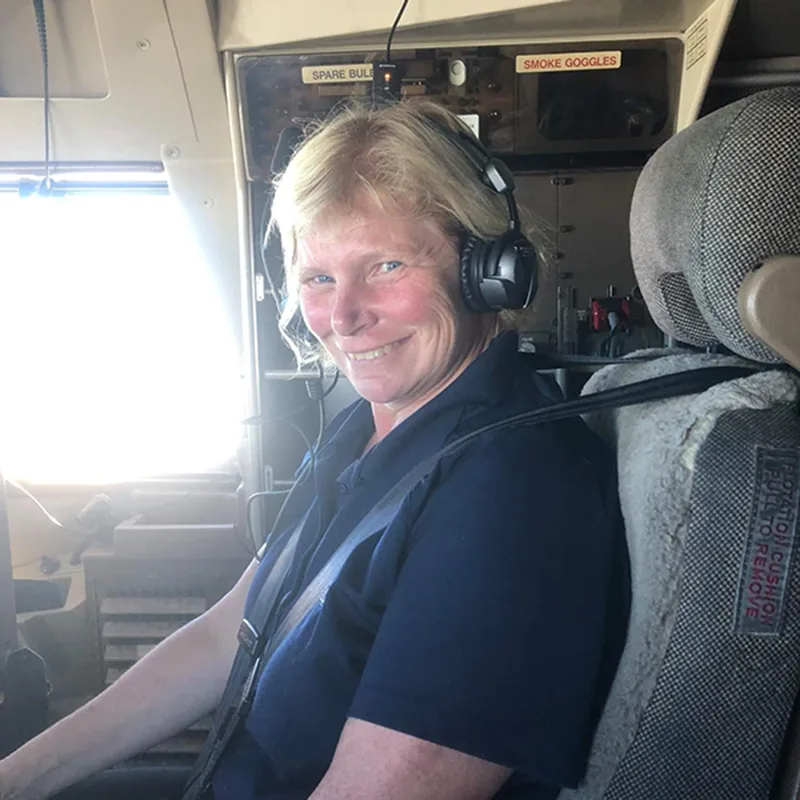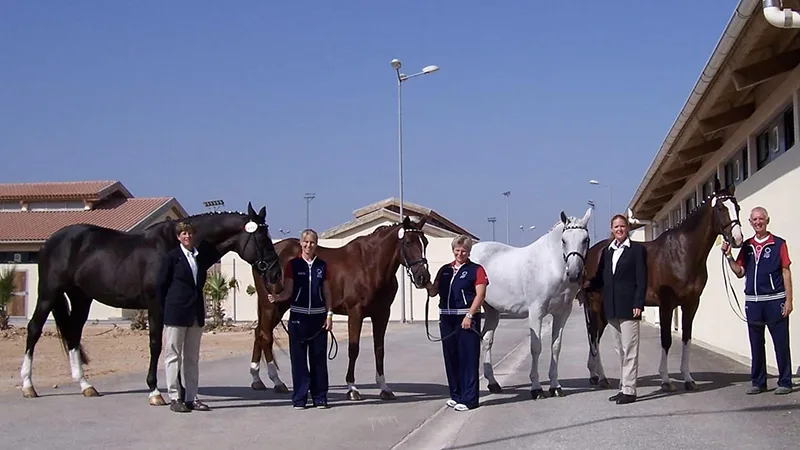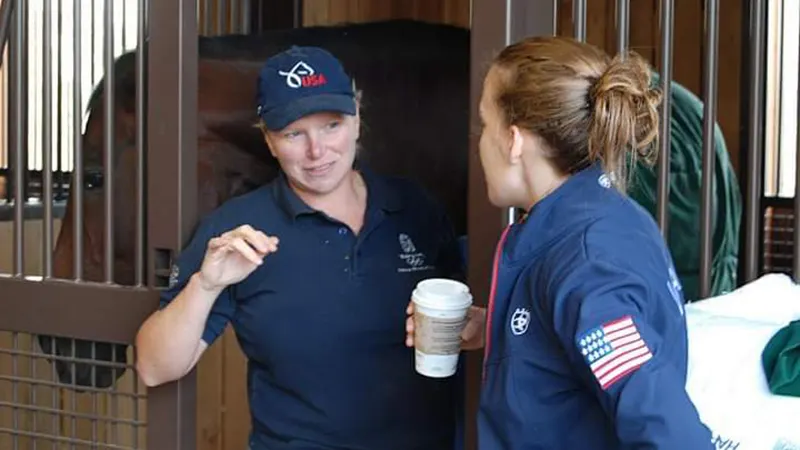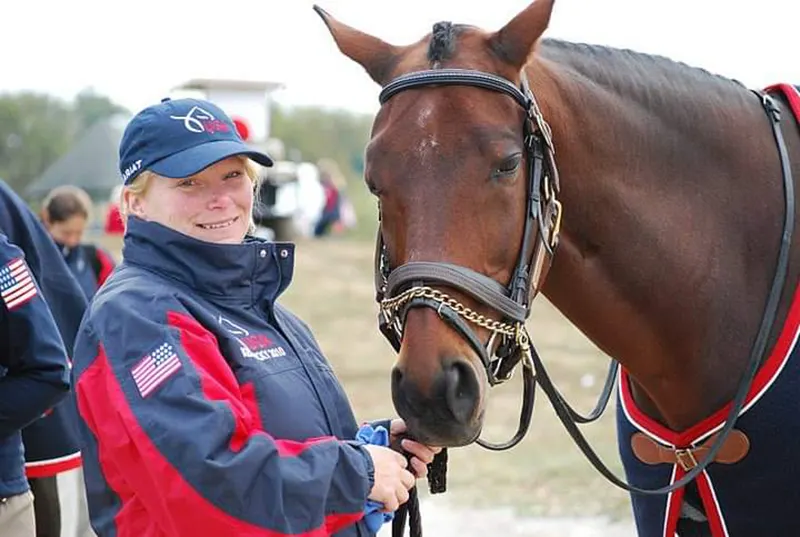Alexandra “Alex” Philpin says she needs to get a real job. She’s been an eventing and dressage competitor, an instructor for 30 years, a barn manager, a British Horse Society instructor, and a groom for eventers, dressage and para-dressage horses at the international level.
But to her, those aren’t real jobs because, en route to her anticipated “real job,” the lure of travel played heavily into her “temporary” choices.
Originally from Wales, she was teaching and competing clients’ horses in England when the opportunity arose to move to the United States. She took a teaching job to Mill Creek Equestrian Center in Topanga, California, and while working there, received a phone call from Karen O’Connor asking if she’d like to groom and manage the O’Connors’ barn.
“That’s what sort of got me into the whole grooming thing,” Philpin said. “I’d never been a groom. So I got on a plane and headed out to Middleburg, Virginia.”
She worked for the O’Connor Event Team for a few years and, through that, was introduced to eventer Missy Ransehousen, whose Blue Hill Farm in Unionville, Pennsylvania, she later managed. She went to the 1995 Pan American Games in Argentina with Ransehousen; it was her first experience flying with horses.
When Horses Fly
“It was a little different back then than it is now,” she said. “You had a pallet of two horses, an open wooden pallet followed by a piece of equipment going all the way down the plane. Your hope was that the pallet of equipment in front of your horse had something that was comfortable on it because you’d probably end up sleeping there.”
Today, the seating arrangements for horses and humans are different, with horses flying in enclosed pallets in the plane’s belly or back and the grooms usually riding up top in comfortable seats. On KLM combo flights, which have passengers in the front half of the plane and horses in the back, being a groom can turn heads.

Alex Philpin has always enjoyed the travel opportunities that come with grooming international competition horses. Photos Courtesy Of Alex Philpin
“The seatbelt light comes on, and everybody’s strapping in, you actually get up and go and stand back with the horses. Of course, none of the regular passengers realize there are horses in the back, and then you come back into the cabin with hay coming out of your hair,” she recounted. “And the flight attendants say, ‘Can we come back and see the horses?’ ”
Philpin counts herself lucky that she’s never had a major problem with horses getting upset on a plane.
“Quite honestly, they travel better in an airplane than they do in a horse trailer,” she said.
A Paralympic Introduction
After working for Ransehousen, Philpin married and moved to Wisconsin where she spent many years teaching and helped design and manage a multi-million dollar private warmblood and Thoroughbred facility.
ADVERTISEMENT
But the urge to travel beckoned when Ransehousen, who by then was coaching the U.S. Para Dressage Team, asked if she’d consider coming to Athens for the 2004 Paralympic Games for a couple of weeks to groom for athlete Keith Newerla.
“I was like, well, yeah, travel is my passion, and bring it on,” Philpin said.
She didn’t realize that decision would open a new phase in her life.
“I had no clue what para-dressage was and how it compared to able-bodied dressage or if it didn’t. I still get goosebumps talking about it,” said Philpin, recounting the very first time she saw the Paralympic riders in the warm-up ring at Athens. “The first time I walked up that hill, and I [saw the warm-up], my jaw dropped because there were all of these horses on the bit.
“[Great Britain’s Sir] Lee Pearson, whom I didn’t know at the time and who is the most decorated para-dressage rider in the world, was working piaffe on his horse. And I was like, whoa, this is not what I expected. The ability that I saw absolutely blew me away.”

Alex Philpin (center) was introduced to para-dressage by Missy Ransehousen (left) when she groomed for Team USA at the 2004 Athens Paralympics.
She remembered being angered by the fact that the Paralympic equestrian competition got no media coverage.
“The U.S. had left one reporter and no camera coverage at all, but one reporter to cover the whole of the Games, not just the equestrians, but every single sport,” she said. “I was furious because these are real athletes. I went on a rant, and I came back, and I wrote to Oprah, but I didn’t hear back. I mean, that’s how it affects me.”
Philpin, who went on to become a certified para-dressage instructor herself, said there is almost no difference between grooming for able-bodied riders and para-equestrians beyond needing to understand what adaptive aids (customized reins or Velcro leg straps, for example) the rider is allowed and, depending on the rider’s disability, providing more help to mount and dismount.
“You have a top athlete, which the para horses are, and they need to be cared for on a high, high level,” she said. “You might have to do a little bit more body work on them because they have to carry the rider a certain way, so they may be a little more sore from time to time. They get all of the lasering and the chiropractor and the physical therapy other athletes do.”
In 2008, she groomed for Rebecca Hart at her first Paralympics in Hong Kong, and later accompanied Hart to the 2012 London Paralympics and the 2014 Alltech FEI World Equestrian Games in Normandy, France.
“She kind of took it upon herself to guide me in those very first deer-in-the-headlights Games I experienced,” Hart said. “It was just a great comfort to know that I had somebody that was not only taking care of the horse but also taking care of me as a rider.
“She was just like a rock that kind of kept me from getting thrown around in this tumultuous sea of international competition,” she continued. “It was great to have that common factor through many years, as I was developing as an international athlete.”

Philpin (left) and Becca Hart having a stall-side chat during the 2010 Alltech FEI World Equestrian Games (Kentucky) where she groomed for Hart.
Hart said she is thankful Philpin taught her how important it is to be sure her horses are mentally and physically happy as athletes.
ADVERTISEMENT
“She really instilled in me that you can be out here competing at the highest level possible, but those horses are always horses, and the horses’ care always comes first,” Hart said. “That horse-care horsemanship is what I think was one of the best things that could’ve ever happened for me as a young, up-and-coming professional rider.”
Working with Hart led to a full-time position with another para-dressage rider Angela Peavy and her mother, Rebecca Reno, at their barn in Florida. Philpin worked several years for them, which included grooming for Peavy at the 2018 FEI World Equestrian Games (North Carolina), before Peavy decided to turn her attention from riding to college and her career.
Reno contacted her friend, FEI dressage rider Arlene “Tuny” Page, to see if she needed an experienced barn manager. Philpin began working for Page at her Stillpoint Farm in Wellington, Florida, and in Amherst, Massachusetts, in April 2020.
Philpin is not only a top-notch barn manager, Page said, she’s also a New York Times crossword whiz who confidently fills the puzzles in ink, she’s drop-dead funny and, thanks to some help from Page’s wine aficionado husband, Dave Page, she’s become a wine expert.

Philpin with one of her many International charges from over the years, Rebecca Hart’s 2010 WEG partner Norteassa.
“My husband loves her,” Tuny said. “He’s right there with her, with the crossword puzzle, making dressage look easy!
“I think the most important thing, of course, is she really, really loves the horses,” she continued. “I can’t go through a show ground without having people stop and say, ‘Oh my God. I can’t believe you’ve got Alex. You’re so lucky!’ ”
Tricks Of The Trade
It takes more than luck to keep high-performance horses happy and healthy, and when it comes to equipment, no matter the discipline, Philpin has some go-to tools:
• A hoof pick—and not just for feet: “You clean the feet out, of course, because no foot no horse,” she said. “But, it can also be used if you have a cheekpiece [on a bridle] that will not come undone for some reason, and you can use the hoof pick to help lever that open. You can use the blunt end when you’re doing stretches with the horse or a tummy lift because it gets a little bit more of a direct pressure. I would be lost without my hoof pick.”
• Epona Tiger’s Tongue Horse Groomer: “It’s like a normal-looking black sponge, but for getting dust off a horse, it’s unbelievable. It’s the best.”
• Elbow grease over silicone-based sprays: “Over time, [they dry out the hair], and the tail hairs snap off,” she said. “The best thing to make a horse’s coat shiny is elbow grease. To be honest with you, it’s currying the horse. You have to find out which curry comb is best for the horse depending on sensitivity.








